The Greeks at sea in WW1
 Circa 40 ships in 1914: 5 Battleships, 3 cruisers, 14 DDs, 32 Misc.
Circa 40 ships in 1914: 5 Battleships, 3 cruisers, 14 DDs, 32 Misc.
Birth of the Greek Navy
Ancient Greece has been the cradle of naval power in the Mediterranean, inventing most of warships types of the antiquity like the diere and famous triere and the first naval tactics were codified. The Hellenistic states founded by the Diadochi, successors of Alexander the Great would also built the largest galleys ever put at sea. However the country was subjected to Rome, before getting its revenge through the Byzantine Empire up to 1453.
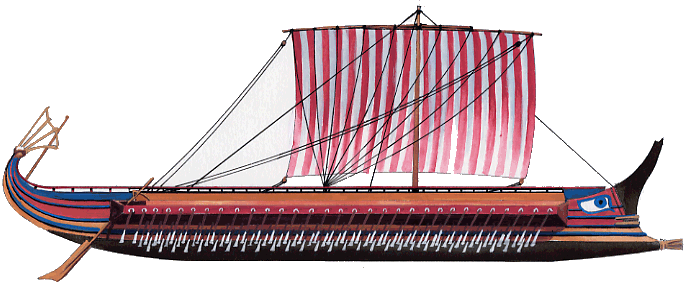
A classic Greek Triere. The great thallassocracies (the terms is greek) were Hellenistic and Carthaginian, before Rome stepped in with unconventional solutions.
After the fall of Constantinople, Greece passed under Ottoman rule. An embryo of Greek Navy emerged from the Independence war of 1821-29, official in 1828. This was a hotchpotch of converted ships, Xebec-like bricks and wooden gunboats, but nothing up to the scale of a Turkish 3-decker. Against ships of the line, Greek sailors used fire ships, with heroes like Andreas Miaoulis. However only the help from western powers and in particular Russia (and its traditional links to the Byzantines through Orthodox Christianity) turned the tables entirely at the Battle of Navarino in 1827, the last with massive numbers of sailing ships of the line and one of the most decisive.
Growth until the Balkan war
But the navy really began its buildup from 1850 onwards. Its flagship was for long a Frigate, the Hellas. A second phase of growth began under King George I of Greece, especially after the 1878 nearby Russo-Turkish war. A large naval base was established at Faneromeni of Salamis and a Naval Academy founded, soon under strong influence from the french doctrine. In 1889 indeed, Greece’s first battleships Hydra, Spetsai, and Psara were ordered from France. This new fleet was seriously tested in the Greco-Turkish War of 1897. It helped establishing its dominance in the Aegean Sea, despite the situation on land. In 1907, the Hellenic Navy General Staff (Γενικό Επιτελείο Ναυτικού) was founded. In response to the Ottoman Fleet own acquisitions and purchased, a new naval race began, Greece ordering from Italy the cruiser Georgios Averof, for long its most potent asset. By 1910, the English style of management, organization and training was adopted, under supervision of Admiral Tuffnel.
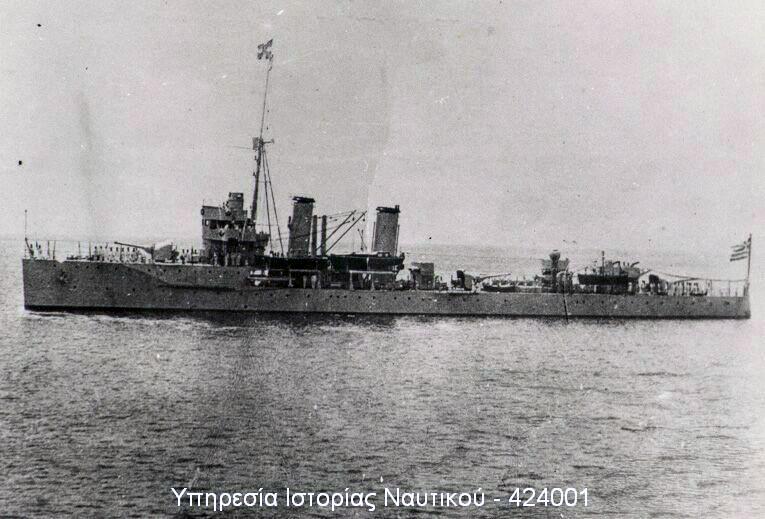
Elli (Hellas), a Cruiser built in the USA, initially for China. By 1941 she has been reclassified as a destroyer
Articles
- Hydra class ironclads (1886)
- Kilkis class Battleships
- Nauarchos Miaoulis (1889)
- RHN Giorgios Averof (1910)
Salamis class dreadnought (project, 1914)
Spetsai class Coastal Battleships (1889)
Cruiser Nauarchos Miaoulis (1889)
Cruiser Helle (1912)
(Reserve)
Basileos Giorgios (1867)
Basilisa Olga (1869)
Sloop Hellas (1861)
Greek Destroyers (1906-1912)
Greek Torpedo Boats (1881-85)
Greek Submersibles (1885-1912)
Greek Gunboats (1861-84)
Greek Minelayers (1878-81)
From a Balkan war to another: The drama of Greek Navy
Facing his old enemy the Ottoman fleet, the Greek fleet was of little weight. Too weak in 1821-29, it was still weak in 1866-68, and during the first crisis of the Balkans in 1885. In 1897 during the war of Thessaly, it was reinforced and now enjoyed the advantage of the canal of Corinth, a cyclopean trench cut from the rock, inaugurated in 1893. The Turkish navy this time did not intervene, as its own state of disrepair condemned it to inaction. With the help of the Europeans, the Greek fleet was considerably reinforced in 1906, France doing a large part of it. From 1911, foreign consultants were employed and the British were preferred for the navy, shaping it.
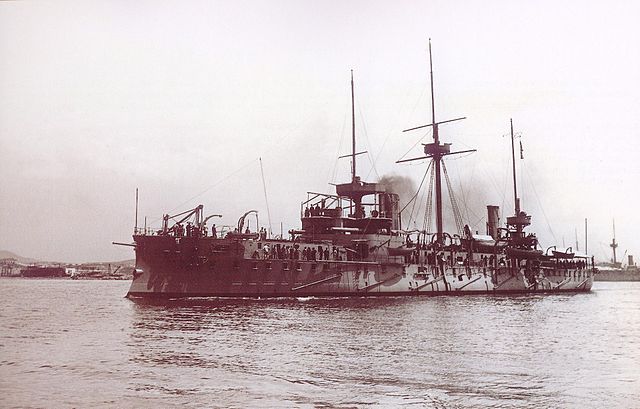
Battleship Psara
The navy thus became considerably stronger as tensions in the Balkans became more acute. So it was the millionaire Giogios Averoff who provately ordered and purchased a powerful ship in Italy on behalf of the Navy (a rare feat in the annals of navies), which gave the Greeks a serious asset against any potential opponent. Meanwhile the three Hydra-class cruisers were rearmed, 6 destroyers were acquired, 2 submersibles and 6 torpedo boats started, 9 cargo freighters were converted into auxiliary cruisers. During the first Balkan war, Admiral Kondouriotis was forced to lead an active defense against the Dardanelles, and to support the troops fighting the Turks in Epirus. Another squadron commanded by Damianos attempted a landing against the Preveza forts in the Gulf of Arta. On October 21, 1912 Kondouriotis’ fleet invaded the island of Lemnos, commanding the entrance of the Dardanelles. Other islands of the Aegean Sea were thus occupied without opposition on the part of the Turks.
The Greeks in particular transported the troops of their Bulgarian allies to Thrace and supported them, but the December 3rd armistice with Bulgaria and the other Balkan states allowed Turkey to extend its forces to the Straits. A meeting took place that lasted 40 minutes but was indecisive. Other meetings were held without convincing results (see “the Balkan war”). An ambitious program, with the order of construction at the Vulkan shipyards of a 20,000-ton dreadnought, the Salamis, but also two other battleships (finally bought in the US) and two twins at the Averof was started, but the armistice May 1913 put an end to its developments.
The head of the British Naval Mission became the Director of the Greek Naval Staff, Sir Mark Kerr, and defined a new plan consisting of 3 light cruisers, 34 destroyers, 20 submersibles, 2 airships, 12 seaplanes and naval vessels. support. With the new Turkish ambitions and the purchase of the Rio for the Brazilians then under construction, a new emergency plan on the eve of the war included two 23,000-ton dreadnoughts, 1 cruiser, 4 destroyers and a submarine.
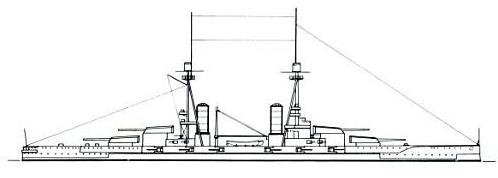
Salamis class battleship final design
Finally, to save time, the Greek government ordered a unit of the type of the Bretagne-class in France, a cruiser bought in the USA and an option on two others. Finally, two battleships were bought in the USA in June 1914, giving Greece a complete naval superiority in the eastern Mediterranean, especially against the Turkish fleet. In 1914, its numbers were important. Here is the detail:
5 Battleships: 2 class Kilkis (1905, purchased in the USA in June 1914), and three battlecruisers class Hydra (1889). Project: Dreadnought Salamis commissioned in Germany in 1913, launched in November 1914, but whose construction was stopped in December 1914 due to constant design changes of its sponsors. It was never completed and demolished in 1932 after a long trial.
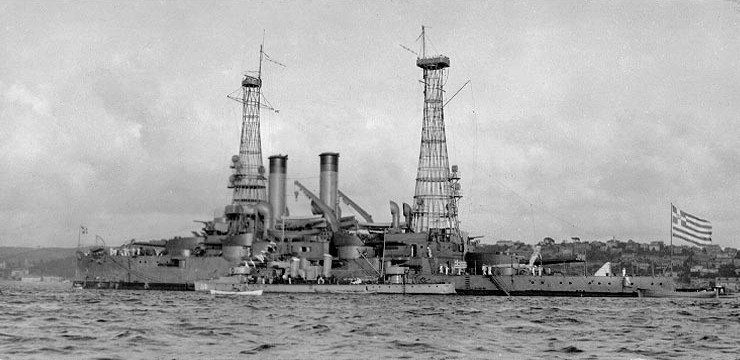
Lemnos 1919
The Greek Navy in the Balkan War
In 1912, conflict erupted again and Rear Admiral Pavlos Kountouriotis conducted operations to secure at Moudros and Lemnos the Dardanelles straits. The the Aegean Sea followed soon. In 1913, the situation escalated so much that the Greek government ordered more ships, taking delivery of two pre-dreadnoughts, battleships Lemnos and Kilkis from the US Navy and the light cruiser Elli also built in the USA for China first, a 2,600 ton Greek protected cruiser later reclassified as a destroyer. But most importantly the government ordered its first two dreadnoughts, the Bretagne class Vasilefs Konstantinos and the German-built Salamis, conventional design from AG Vulcan, Hamburg. None of them were delivered because of the Great War.
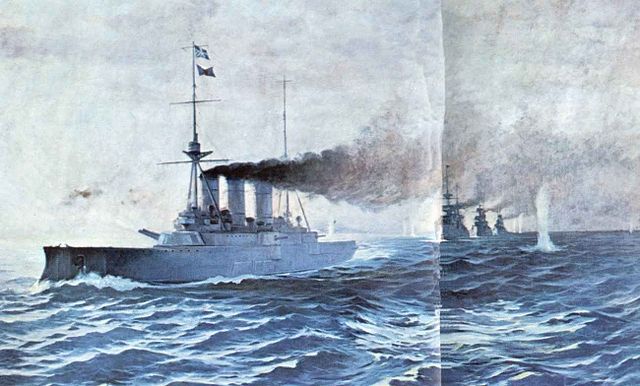
Battle of Elli, 16 December 1912, decisive Greek victory
The Greek Navy at the eve of WW1
In August 1914, Greece remains neutral, exhausted from the Balkan war and weary of a possible takeover of the central powers. At that time, the Hellenic Navy was strong enough to take on the Ottoman navy, by a margin, despite the not receiving its numerous orders.
The head of the British Naval Mission that became the Director of the Greek Naval Staff, Sir Mark Kerr, defined a new plan consisting of 3 light cruisers, 34 destroyers, 20 submersibles, 2 airships, 12 seaplanes and naval vessels. Turkish ambitions has been then clearly shown by the attempted purchase of the Rio de Janeiro for the Brazilians then under construction, and a new emergency plan on the eve of the war in this summer of 1914 included two 23,000-ton dreadnoughts, 1 cruiser, 4 destroyers and a submarine.
By the time the two Kilkis class battleships bought in the USA arrived in June 1914, they gave Greece a complete naval superiority in the eastern Mediterranean. Here are the detail of this fleet:
-5 Battleships: 2 class Kilkis (1905, purchased in the USA in June 1914), three armoured cruisers class Hydra (1889). Projects: Salamis (Germany, 1913, launched November 1914, construction stopped in December 1914), purchase aborted of a Provence class sistership.
-3 Cruisers: Armoured cruiser Giorgios Averof (1910), cruiser Helle (1913).
-14 Destroyers: 4 class Niki (1906), 4 class Thyella (1906), 4 class Aetos (1911), 2 class Keravnos**.
11 TBs: 6 Class Aigli***, 5 class NF11 (1885).
32 Miscellaneous: 2 submersibles class Delfin (1911), Minelayers Tenedos (1906), 3 class Aigialeia (1881). 4 Gunboats class Achelaos (1884), 2 class Ambrakia (1881), 2 class Kissa (1884), 3 class Alfa (1880), 2 class Plixavra (1858), training ship Basilissa Olga. And the RHN Nauarchos Miaoulis* (1879).
Also planned later: dreadnought battleships Basileus Konstantinos, Katsonis class cruisers.
*The old Nauarchos Miaoulis (1879) in 1914 he served as a training ship for gunners.
**of the 14 Destroyers, the Keravnos class were purchased from the Germans 1912.
***Among the 11 TBs, the Aigli class were of German construction in 1912
Tonnage 1914: Battleships 5 – Cruisers 2 – Destroyers 14 – Miscellaneous 32
The Greek Navy during the First World War:
Naval operations
With the beginning of the war it became clear that the orders started in Germany and France would never see the light of day. Sir Mark Kerr, tried to get the British to finance a Valiant-type battleship and a Southampton cruiser, with a deferred payment at the end of the war, but without much success. Greece stayed neutral at the beginning of the Great War, but constantly solicited by Churchill to assist the Royal Navy and the French Navy at the Dardanelles, even while Bulgaria was on his side. But internal political turmoil between a pro-German faction in the court of Constantine I and sympathizers of the Allied caused eventually the French to seize the entirety of the Greek fleet on 19 October 1916 to guarantee this neutrality. Some units passed under the French flag and control but with limited crew for maintenance.
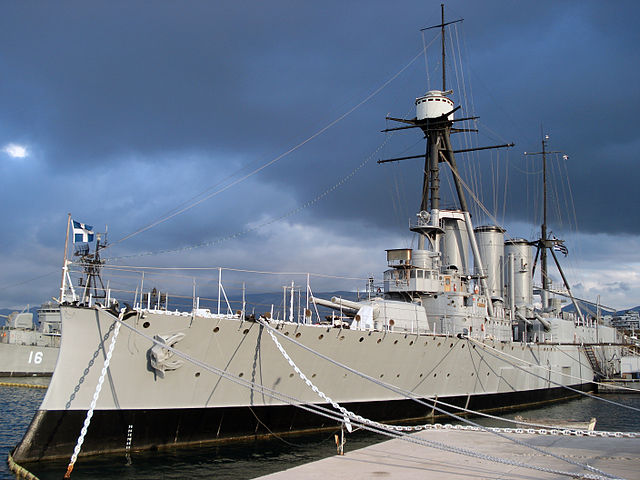
Armoured cruiser Giorgios Averoff, named after the Tycoon that financed her for the Greek Government.
After French troops landed at Salonica, a new provisional government hostile to the Monarchy was established, and Alexander I eventually abdicated in favor of his more liberal son Georges II. On July 2, 1917, Greece entered the war against the triple alliance, lending its ports to allied ships. With the surrender of Turkey in 1918, the Greek government saw the means of appropriating lands of the Ottoman Empire. On May 15, 1919, the fleet deployed and Greek troops landed in Asia Minor, seizing Western Anatolia and Izmir. The Treaty of Sèvres in 1920 confirmed the possession acquired in the Aegean Sea, but the Turkish counter-offensive finally forced the Greeks to leave Turkey at the end of 1922.
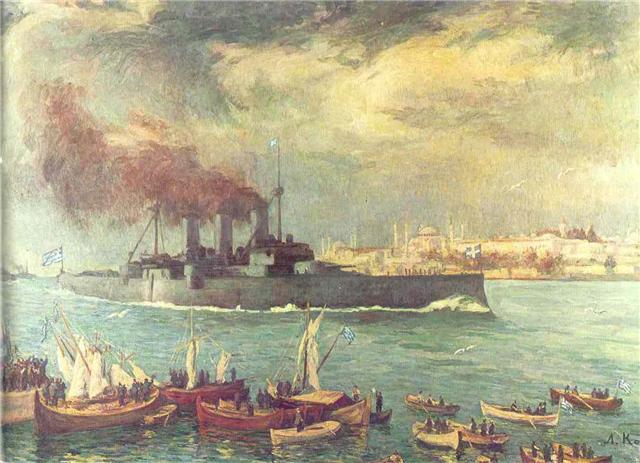
Averoff in the Bosporus, 1919

RHS Lemnos in 1919, a 1914 acquisition for the US. Both ships would still be in service by 1941.
With the beginning of the war in August 1914, it became clear that dreadnoughts started in Germany and France would never see the light of day. The government, through the voice of the naval minister Sir Mark Kerr, tried to get the British to finance a Valiant-type battleship, and a Southampton cruiser, with a deferred payment at the end of the war, without success. Left neutral at the beginning of the Great War, Greece was constantly solicited by Churcill to assist the Royal Navy and the French Navy, even while Bulgaria was on his side, against the Tuque fleet to open the dardanelles the second expected front. But internal political disturbances between a pro-German faction in the court of Constantine I and sympathizers of the Allied cause led to a forcing of the French who unceremoniously seized the entire Greek fleet on October 19, 1916. The legions passed under the French flag and control while the heavy units saw their crew reduced to little.

Giorgios Averoff, now preserved at Pireus.
After the disembarkation of the French troops at Salonica and aided by a fringe of the population hostile to the Monarchy, a provisional government was established, and the internal disturbances helped by the allied army made Alexander I to leave his throne, abdicating in favor of his son Georges II. On July 2, 1917, Greece entered the war against the triple alliance, lending its ports to allied ships. With the surrender of Turkey in 1918, the Greek government saw the means of appropriating landless important plots of the Ottoman Empire. On May 15, 1919, the fleet deployed and Greek troops landed in minor Asia, seizing Western Anatolia and Izmir. The Treaty of Sèvres in 1920 confirmed the possession acquired in the Aegean Sea, but the Turkish counter-offensive finally forced the Greeks to leave Turkey at the end of 1922.
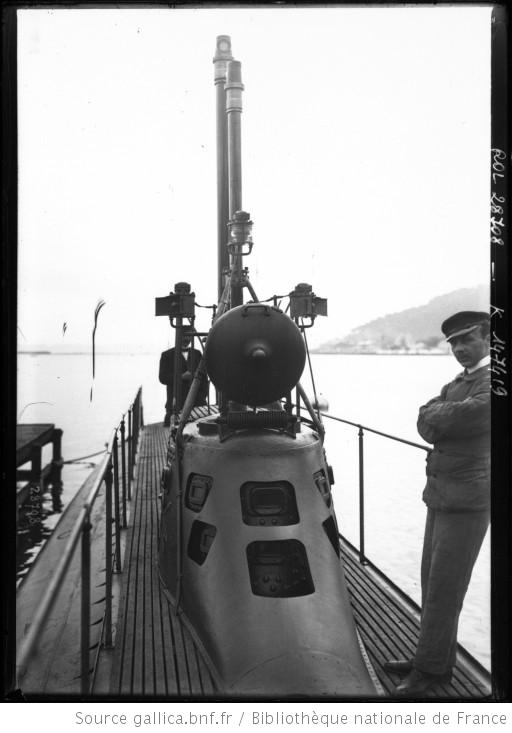
Kiosk of the Delfin in 1913 (Gallica, CC)
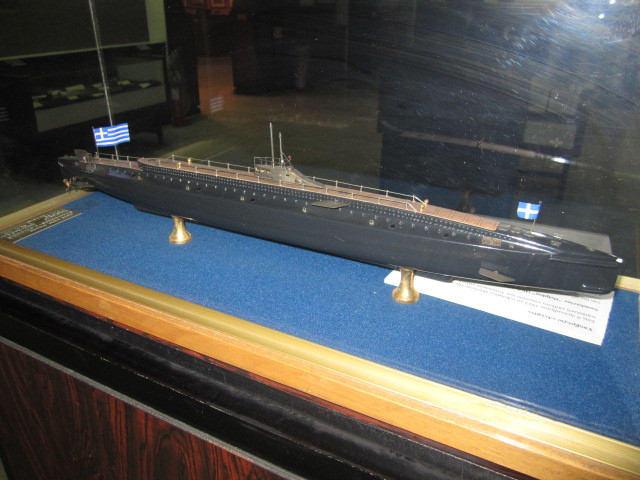
Model of the Delfin in Athens Marine museum (CC)
Read the following part, the Greek Navy in ww2.
Greek Projects
RHN Salamis (1912).
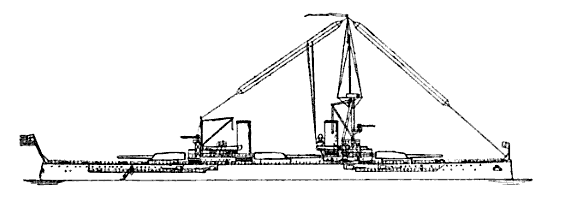

First and second designs of the 20,000 tons Salamis, built in Germany, by Vulkan AG. The ship would eventually be launched in November 1914 but only partially completed when all construction stopped in December. She would never receive her US-built guns, and after a long postwar procedure because the Greek government refuse the incomplete ship, she was awarded to the Shipyard, which eventually have her broken up in 1932.
RHN Salamis, ordered in 1912 to Vulcan yards, should have ruled the Aegean with ease. Not superfast compared to super-dreadnought designed which happened just one year later at 21 knots, she fast enough to work with the modern cruisers Elli and Averoff, and distance the Barbarossa class of the Ottoman navy, but it was merely intended to deal with the recently ordered Sultan Osman I and its fourteen 12-in guns and Reshadieh and her eight 13-in guns. Instead, the Greek battleship was equipped outright with 14-in guns (356 mm) ordered to Bethlehem steel in USA. Ironically, this caliber was larger than what carried any German battleship in construction at the time. Delivery was planned for March 1915 as contracted and when the war brok out, the ship was still month from launching. The war reaffected priorities. Germany needed new battleships fast and therefore, to free the Vulcan’s yard slipway occupied by Salamis, so she was launched in emergency when the hull was still incomplete, on 11 November 1914, and by administrative decision all work stopped on 31 December 1914. The hull was brthed nearby in Hamburg, waiting her fate. Negociations with the Greek Government started again in 1918, in a vastly different context, so international arbritration was necessary since Greece already paid 450,000 over the 1,693,000 pounds stated in the 1912 contract, and the abritrators asked Greece to pay another 30,000 pounds to Vulcan while the ship would remain the property of the yard. She was eventually scrapped in 1932. This will be seen in great detail in a dedicated post.
RHN Basileus Konstantinos (1914).
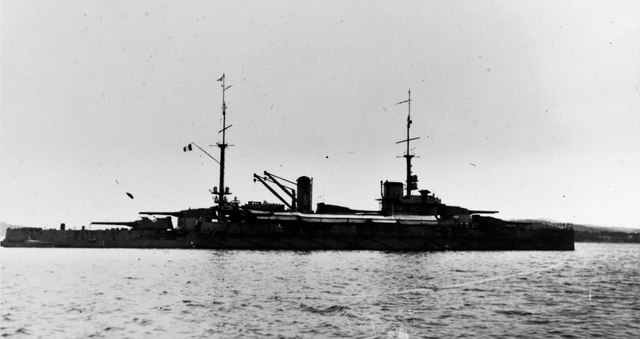
For a second dreadnought, to counter the recently ordered Reshadieh (future Erin in british service), the Greek Government could not asked Germany for a second ship as it was already at full capacity, but France, which announced having a free slipway and plans ready for such eventuality. An agreement was passed for a fast delivery in April 1914 of a clone fo the Provence class, armed with ten 340 mm (14 in), and heavier than Salamis at 23,500 tonnes standard. The only design changed asked for was the replacement of French light artillery by US-pattern 3-inches Bethlehem guns. Work started in Penhöet St nazaire yard on 12 June 1914 (Just Freed from Lorraine, anothr of the class), but stopped in August and never resumed. The unfinished hull was still the yard’s property but some payment had been done already. So the yard scrapped and recycled the already assembled material, and freed the basin, but the dispute was only settled in 1925.
Katsonis class cruisers (1914).
To go with the two dreadnoughts in 1915-16, Greece also planned to acquire modern cruisers. For once, they were ordered to Great Britain. A contract was signed with Cammell Laird in June 1914 for two 5,200 tonnes Town class vessels, later known as the “Birkenhead subtype”. Indeed, the RHN Katsonis and Kondouriotis were both requisitioned soon after August 1914, purchased on the stocks and completed as HMS Birkenhead and Chester.
Read More/Sources
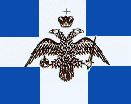
Conway’s all the worlds fighting ships 1860-1905 and 1906-1921.
Paul E. Fontenoy, Sumbarines, ABC-CLIO, 2007
http://dossiersmarine1.free.fr/eu_gr.htm
Zisis Fotakis, Greek naval strategy and policy, 1910–1919, Routledge, 2005
Bernd Langensiepen, Ahmet Güleryüz, The Ottoman Steam Navy, 1828–1923, Conway Maritime Press
Lawrence Sondhaus, Naval Warfare, 1815-1914, Routledge, 2001
Ελληνικά Υποβρύχια: 110 Χρόνια Ιστορίας (Sommergibili greci: 110 anni di storia) 1996
https://www.hellenicnavy.gr/en/fleet/209-en/organization/fleet-headquarters/submarines-command/1228-history.html
https://www.mezeviris.gr/
Nomenclature of Hellenic ships in WW1
 Kilkis class battleships (1914)
Kilkis class battleships (1914)

Ceetainly among the best ships Greece had in 1914, and only capital ships, the Kilkis class were the former, and last USN pre-dreadnoughts of the Mississippi class. They were somewhat hybrid ships, with a powerful secondary artillery. Mississippi and Idaho already shown in Greece while in the “great white fleet” before the war. Instead of being sold for scrap, freeing crews for the new dreadnoughts, they were acquired by Greece in June 1914, when war was looming again in the Balkans. It was a bold move for a modest naval power, but understandable given the context of recent Turkish acquisitions. Kilkis and Lemnos saw little service however, had a limited overhaul in the 1920s, used as schoolships or in the reserve coast guard, and ended sunk by the Luftwaffe in the Piraeus in 1941.
 Armoured Cruiser RHN Giorgios Averof (1910)
Armoured Cruiser RHN Giorgios Averof (1910)

Not a capital ship but probably the best and most famous Greek warship of that era, the world’s only armoured cruiser preserved today, in Thessaloniki. RHN Giorgios Averoff was partly privately funded, therefore named after its main benefactor. Built in Italy, it was a repeat of the rather good Pisa-class. But rarely a warship has been given the privilege of a very long career as flagship of an entire navy, nor having such historical significance. RHN Giorgos Averof was ordered in 1908, and fought during the Balkan war in 1912, WW1, WW2 and was still in service in 1952, seeing the early cold war.
 Hydra class ironclads (1889)
Hydra class ironclads (1889)
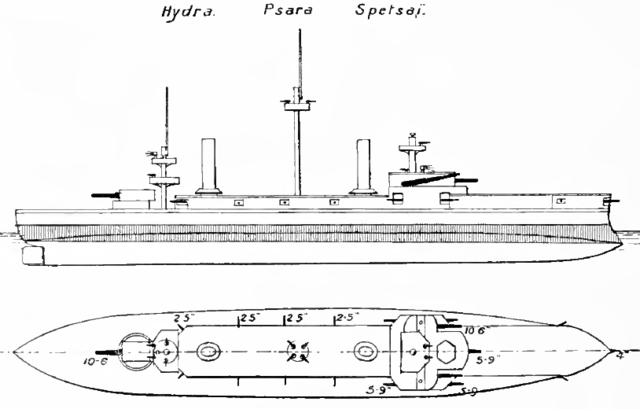
Relegated as training ships in 1914, these three ships built in France in 1889-90 were coastal battleships, well armoured but armed with 10.8-inches guns (274 mm) Canet gun and a light artillery which had been completely modernized in 1914. They had a two-story battlery forward, accomodating four secondary guns on the lowest deck, and the two longer barrel main guns and shorter one firing over the top of the superstructure floor; Another oddity of the “young school” their military value was dubious in 1914, but their main artillery still packed a punch, being heavier than the Averoff, at least on paper. The cruiser’s main arillery was much more modern and better service with a modern fire control system. Plus there three ships were slow, as shown in the Balkan war naval battles, they were just left behind by Averoff. Hydra was in 1914 a gunnery training ship, Psara trained engine-room personnel and they were later reactivated as coastal defense ships, but decommissioned in 1918. All three were sold in 1929.
Hydra class Specifications 1914 |
|
| Displacement | 4,800 long tons standard |
| Dimensions | 102 x 15.8 x 5.49m (335 x 51 x 18 feets) |
| Propulsion | 2 shafts VTE, 8 Normand boilers, 6,700 shp |
| Speed | 17 knots, coal 690t |
| Armament | 3x 10.8 in/34/28, 1x 3.9in/50, 8x 9-pdr, 4x 3 pdr, 10x 1pdr, 1x 15 in, 2x 14 in TTs |
| Armor | Creusot Compound Belt 4-12in, Battery 12-14 in, Barbettes 12 in |
| Crew | 440 |
 Cruiser RHN Helle (1913)
Cruiser RHN Helle (1913)

Certainly with the Averoff the most recent and best warship in th Hellenic Navy in 1914. She was the ex-US built Fēi Hóng, a Chao Ho clas cruiser built for China, but at the time of delivery, the Chinese revolution made the order cancelled. Greece acquired it also at the time of the Balkan was. For WW2 standards she was more of a destroyer by her general appearance and tonnage, but in WW1 she was certainly better armed than any destroyer afloat. She was also fast with 26 knots, certainly able to team with Averoff.
Elli saw action during the war, despite the “National Schism”. In November 1916 she confiscated and operated by the French Navy, for convoy escort and patrol duties in the Aegean until retoceded to the Greeks in June 1917, and was back in the Aegean with Greek crews. A good match would be the Hamidieh and Medjidieh, but teaming against them with Averoff was a sure win. Sunk in 1940 by an Italian submarine, the name Elli was resurrected after WW2 by an ex-Italian cruiser given as war reparation.
Elli Specifications 1914 |
|
| Displacement | 2,115 t standard, 2,600 t full load |
| Dimensions | 98 x 12 x 4.3m (321 x 39 x 14 feets) |
| Propulsion | 3 shafts VTE, 4 BW boilers?, ? shp |
| Speed | 26 knots |
| Armament | 3x 6 in/54, 3x 3in/50, 3x 2-pdr, 2x 19in TTs, mines |
| Armor | Unknown, probably 2-in armour deck |
| Crew | 238 |
 2nd class cruiser Nauarchos Miaoulis (1879)
2nd class cruiser Nauarchos Miaoulis (1879)
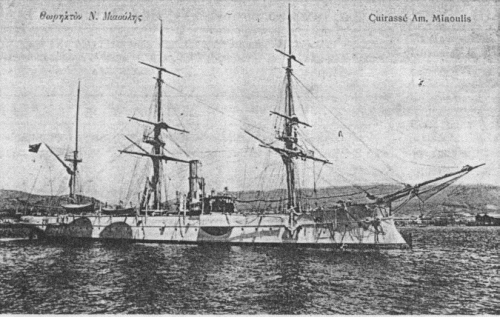
No longer “active” but still enlisted in 1914 was the very old Miaoulis, a master unprotected cruiser built in France in 1879. She was stricken in 1912, hulked as gunnery TS and static seamen’s TS after WW1, sold in 1931.
Quick specs: Displacement Standard 1,820 tons, 75 x11 x 4.4m m (246 x 36 x 14 ft), one shaft VTE 2,400 shp (1,800 kW), 13.5-knot (25 km/h), crew 180. Armed in 1914 by the same original artillery: Three sponons guns 6.7 inches 173mm/22 RK L/25 C/74, one 173mm/17 RK L/20, six 37mm/20 Hotchkiss revolver, 3x 356mm TT (1 bow, 2 beam).
 Destroyers class Niki (1906)
Destroyers class Niki (1906)

350 tonnes boats built at Vulcan, Stettin: Niki, Doxa, Aspis, Velos, ordered at the same time as the Thyella class in UK. Doxa was sunk by UB 47 off Sicily. Two were rebuilt and fought in WW2. Also, former German destroyers from Vulcan, V5 and V6 built in 1912 were in sevrice in 1914: Purchased when completed, they became Keravnos and Nea Genea. They mostly served in French hands 1917-18 and were sold in 1919.
Two more 800 tonnes destroyers were also ordered to Schichau in 1914 and requisitioned, becoming S35 and S36 in German service.
| Displacement | 350 t standard, 370t full load |
| Dimensions | 67 x 6.6 x 2.7m (219 x 21 x 8 feets) |
| Propulsion | 2 shafts TE, 4 navy boilers, 6500 shp, 30 kts |
| Armament | 2x 12 pdr, 4x 6pdr, 2x 18in TTs |
| Crew | 59 |
 Destroyers class Thyella (1906)
Destroyers class Thyella (1906)

Same specs but ordered at Yarrow: Thyella, Nafatoussa, Lonchi, Sfendoni. Nafkatoussa was wrecked on Milos island. Two were refitted 1926 with German 88 mm guns and fought in WW2.
| Displacement | 328 t standard, 380 t full load |
| Dimensions | 67.1 x 6.2 x 1.8m (220 x 2 x 6 feets) |
| Propulsion | 2 shafts VTE, 4 Yarrow boilers, 6000 shp, 30 kts |
| Armament | 2x 3-in, 2x 6pdr, 2x 18in TTs |
| Crew | 70 |
 Destroyers class Aetos (1911)
Destroyers class Aetos (1911)

Much larger vessels ordered in UK, Camell Laird, in 1909 originally by the Argentine Navy and resold in 1912 to Greece: Aetos, Ierax, Panthir, Leon. The “cats” were seized by the french like the others in 1916 then sent back in 1917, except Panthir. They had Bethlehem guns and were all rebuilt in the 1920s, and active in WW2. They were a clear step up, superior to any Turkish destroyer with their turbines, long range QF armament and heavy torpedoes. The even larger Kriti class was also ordered but they were sized while in contruction in 1914 and ended in the British Royal Navy. Greece also obtained as war reparation the ex-Austian 1911 Ulan in 1920, renamed Smyrni.
| Displacement | 980 t standard, 1175 t full load |
| Dimensions | 89.3oa x 8.4 x 2.6m (293 x 28 x 8 feets) |
| Propulsion | 2 Parsons turbines, 5 WF boilers, 22,000 shp, 32 kts |
| Armament | 4x 4in, 4x 21in TTs |
| Crew | 90 |
 Greek Torpedo Boats
Greek Torpedo Boats
In 1914, the Greek Navy had modern eight frontline torpedo boats (TB) and in 1903, seventeen second class vessels, dating back from the 1880s. Of few of the latter were extant. After the war, Greece acquired three ex-Austrian (Panormos class) and three more (Kyzikos class). A dedicated post will be written about them.
Aigli class (1912)
First class TBs built in Germany, in Vulcan, Stettin: Aigli, Alkyoni, Arethousa, Doris, Dafni, Thetis. Completed in 1913 with US Bethlehem guns. Seized by the French in Dec. 1916, back in Greek service in 1917. the same scheme applied to other recent TBs. Quickspecs: 120 tons, 45 x 5 x 1.2 m, 1 shaft VTE 2400 hp, 24 kts, 2x 6pdr, 3x 18 in TTs.
Nikopolis class (1906)
Ex-Turkish Tokat and Antalya sunk by the Italians at Preveza in 1911 and later refloated and repaired by the Greeks in 1912, rearmed with two 1-pdr, one TT, renamed Tatoi and Nikopolis, both stricken in 1916.
V 11 class (1885)
Torpilovo T11-T14, built in Vulcan, Stettin, armed with one 37mm/17 Hotchkiss, 2x 356 TT in the bow and one trainable TT. Two active 1914: No11 was wrecked 13.4.1913 near Mudros Bay, No12 sunk 28.3.1900 by a boiler explosion in the Salamis Channel.
Ionia, Ferenikioi & Samos classes (1881)
French built (La Seyne): 31 tons Sfinx, Ionia, discarded before 1914. Also French built 42 tons Fereniki, Terpsihori, Persefoni, Terpsithea, Kalithea, discarded 1905. And the 40 tons Yarrow built Samos, Khios, Mitilini, Kos, Rodos, Kipros discarded 1910.
 Nordenfelt I (1885)
Nordenfelt I (1885)
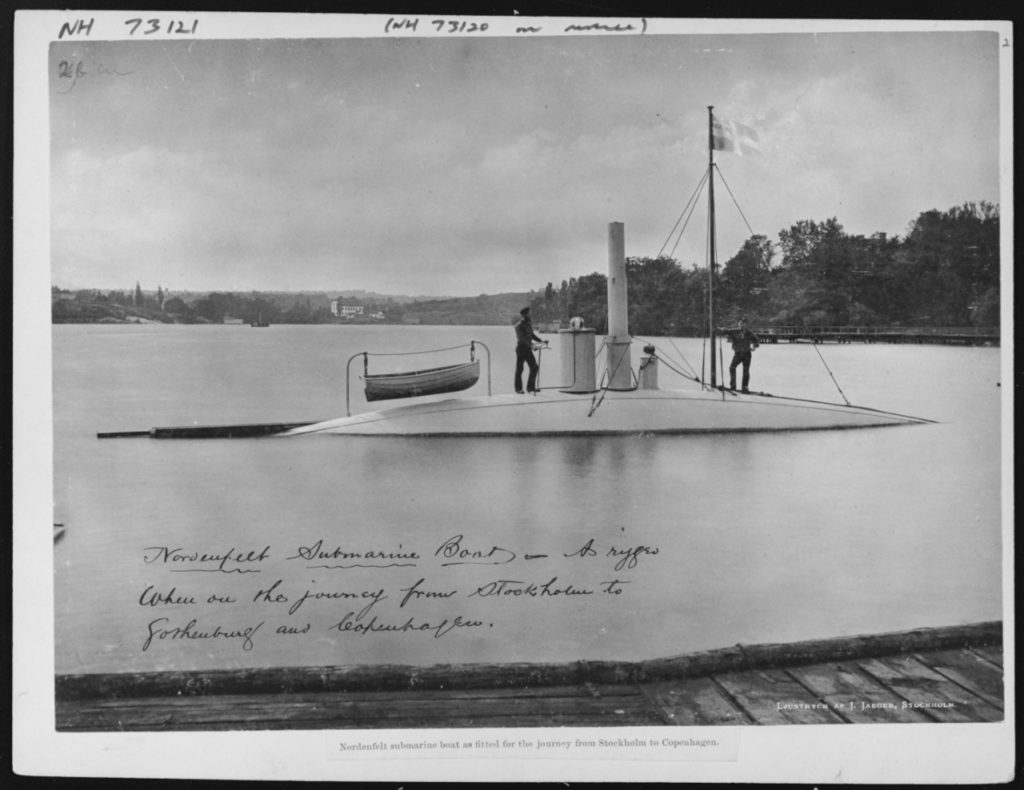
The story of Greek submarines is an interesting one. It started very early in fact with the… bell of Alexander the great but i digress. The first ever Greek submarine was barely one: It was a Nordenfelt I model, purchased in 1885. The Nordenfelt I was a 56-tonne, 19.5-metre long boat that translated the British Reverend G. Garrett own design Resurgam of 1879. Its on-paper range was 240 km, and it had a single torpedo plus a 25.4 mm Nordenfelt machine gun. Bolinders manufactured in in 1884-1885. It was propelled by a 100 HP steam engine, to 9 knots, shut down when diving with sufficient steam remaining for some underwater final approach to the target. Ballasts were managed by steam-driven pumps and added to the action of two vertically screws over the deck. Desmonstrated in Landskrona, famous weapons seller Basil Zaharoff actively marketed it for Greece, and she was sent to the Salamis Naval Base in 1886 to started acceptance trials, that she failed. Therefore she remainded enlisted, but was never used operationally and scrapped in 1901.
 Delfin class Subs (1911)
Delfin class Subs (1911)
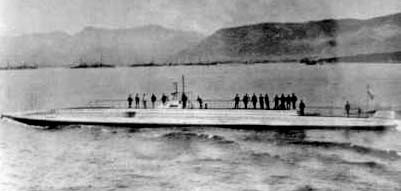
In 1908, Greece has not been repelled for the idea of acquiring submarines and that year, started a survey to find the best provided. Its traditional supplier, France, was naturally chosen, also largely due Laubeuf’s design was praised at the time, just adopted for large production in France. Therefore in 1909, two were ordered at Schneider in Châlons, launched in 1911 and 1912 respectively. Called Delfin and Xifias, they had an internal TT in the bow and four external ones, displaced 460 tonnes underwater, were capable of 1.5 knots on surface and of course, were diesel-electric. On 9 December 1912, Delfin ambushed Turkish vessels off Tenedos and fired at them, but missed. That was a first for Greece anyway. The feat was performed by Lt Col. Paparrigopoulos which sighted the cruiser Medjidieh leaving the dardanelles with an escort, fired at 500 mm but the torpedo did not ran properly and missed. Both were captured in 1917 by the French and used until 1918, used by Greece until discarded in 1920. The Greek government already in 1912 ordered two more Laubeuf types (improved), provisionally named X and PS, but they were seized while in construction in 1915 and became Amazone and Antigone in French service. Also in July 1914, the Greek Government approached Germany for the sale of two Kiel Germeniawerft’s boats, U-33 and 37, but the sale was cancelled after just one month.
| Displacement | 980 t standard, 1175 t full load |
| Dimensions | 89.3oa x 8.4 x 2.6m (293 x 28 x 8 feets) |
| Propulsion | 2 Parsons turbines, 5 WF boilers, 22,000 shp, 32 kts |
| Armament | 4x 4in, 4x 21in TTs |
| Crew | 90 |
 Tenedos class minelayers (1906/1916)
Tenedos class minelayers (1906/1916)
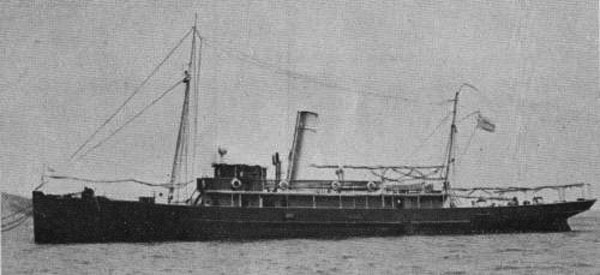
The largest Greek Minelayers in WW1, they are in the same class for practicity. In reality two different ships. RHN Tenedos was originally ordered in UK in Glasgow, launched 1906, comm. in 1907. She had one funnel, swan bow, two masts schooner rigged, but unarmed apart the 40 mines she carried. She was captured from the Turks in October 1912, and used also as a dispatch vessel and lighthouse tender. She was seized by the French in December 1916 and used until 1918. Still extant in WW2, she was sunk 23 april 1941 by the Luftwaffe in the saronic gulf, refloated and repaired, used as the auxiliary UJ-2106 and sunk in June 1944 by HMS Unsparing off Cape Maleos in the Pelopponese. Quickspecs (1914): 450 tons, 43.3 x 7.3 x 3.4 m (142 x 24 x 11 ft), 1 shaft VTE, 2 boilers, 560 bhp or 13 kts, coal 40 tons.
On her side, Korgialenos was purchased to Rotterdam yard in 1916 by M. Korgialenos, and was used also as dispatch vessel. Captured by the French duiring WW1, sunk by the Luftwaffe 23 April 1941, refloated and rused as UJ-2210 until October 1944, when sccuttled in Salonika. Quickspecs: 380 tons, 45.7 x 6.6 x 3 m (150 x 21 x 10 ft), 1 shaft TE 550 ship 13.5 kts, 35 tons coal, 50 mines.
Also in 1918 the Greeks purchased four trawlers, renamed Y1-Y4, used as minesweepers to clean up the aegean sea at the end of the war and after. These were 140 tons, 10 kts vessels armed with a 12-pdr Krupp. Two were discarded in 1922, the remainder in 1925. Two more auxiliary vessels were also used as minelayer durung the war of 1912: The steamer Aris and Mykonos. The second was returned in 1913 but the first also fought in WWI. They also purchased three admiralty type motor launches (built 1916) in 1920, B1-B3, discarded in 1925, and in 1921 a unique thornycroft 45 feet CMB type motor torpedo boat, experimented until mothballed in 1933.
During the Balkan war of 1912-13 the Greeks operated no less than nine merchant steamers as auxiliaries, armed as AMCs: Sapfo, MThemistoklis, Pelops, Athinai, Makedonia, Esperia, Arkadia, Mikali, Sfakiria. Makedonia was sunk by Hamidieh off Syros. During WW2 the Greeks did the same with other ships: Konstantinopolis (A), Chios (B),Vassilissa Sofia (C), Aigaion (D), Hermis (E), Naxos (F), Adriatikos (H), Aktion (TH), Mykonos (I). These armed merchant cruisers served for the duration of the Greek engagement with the allies in 1917-18 and were back to their civilian duties after the war.
 Aigialia class minelayers (1881)
Aigialia class minelayers (1881)
Three vessels, Aigialeia, Monemvasia and Nafplia, built for mine transport but which can lay mines as well. They were used durng the Balkan war and WW1 as well, discarded in 1933. Quickspecs: Displacement 300 tons, 23.0 x 4.00 x 2.60m, 1 shaft VC engine 300 bhp,9 kts, sole armament: 20 mines.
 Achelaos class gunboats (1884)
Achelaos class gunboats (1884)
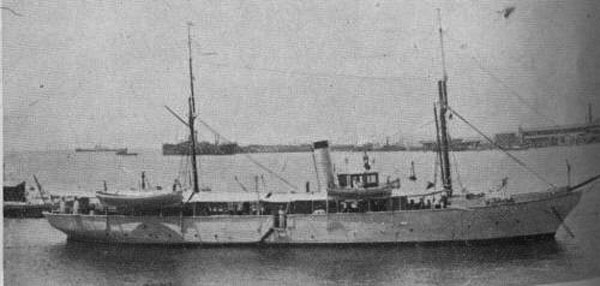
Achelaos, Alpheos were built by Thames Iron Works, Eurotas, Peneos by Denny. 404 tons, 131 ft 3 in long (40 m), 400 ihp for 10.5 kts, armed with two 3.8 in/26 guns (96 mm), and three 1-pdr QF guns (37 mm).
 Ambrakia class armoured gunboats (1881)
Ambrakia class armoured gunboats (1881)
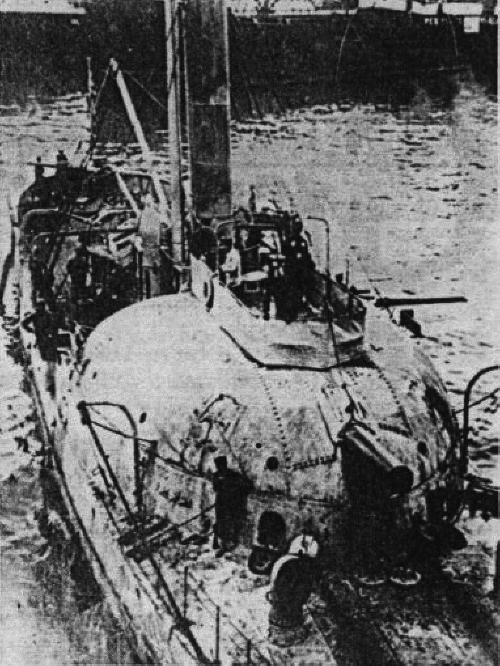
Ambrakia and Akteon were originally ordered as Hydra and Spetsai, and renamed to free those for the ironclads. They were built in Thamese iron works, specs 433 tons, 128 ft (39 m) long, 350 ihp for 10 kts, armed with a single 10.2 in/30 (263mm/27 RK L/30 C/84 main gun), and a 5.9 in/30 Vickers guns plus two 1-pdr (Hotchkiss 37 mm) and a 14-in (356 mm) bow torpedo tube. They were also armoured, with the main gun enclosed in an hemispheric casemate protected from small caliber fire and shrapnel. In service until the 1930s.
 Ambrakia class gunboats (1880)
Ambrakia class gunboats (1880)
Sfaktiria, Mykali, Nafpaktia and Ambrakia were ordered in France, to F C de la Méditerraneé, La Seyne, Toulon. They were small screw gunboats listed as torpedo boats due to spar torpedo carried. Specs: 52 tons, 22 x 4.50 x 1.50m, armed with a a 149mm/24 RK L/26 aft (later two Hotchkiss 37 mm QF guns) and a 356 mm spar torpedo. Renamed Alfa, Beta, Gamma, Delta before WW1 and Gamma was sunk in 1918 off Psyttaleia. The others were discarded in 1920. The Greek navy also had a small coastal gunboat Aidon (1884), wrecked in 1924 off Aegina Island, and the Kichli and Kissa buult in Thames Iron Wks, Blackwall. Displacement 86 tons, 24.2 x 4.88 x 2.13, 1 shaft VC 162 ihp, 10 kts, carried 20 tons of coal. They looked like small schooners. In 1939 Kichli was used as a minelayer and sunk in April 1941 by the Luftwaffe.
 Basilissa Olga training vessel (1869)
Basilissa Olga training vessel (1869)
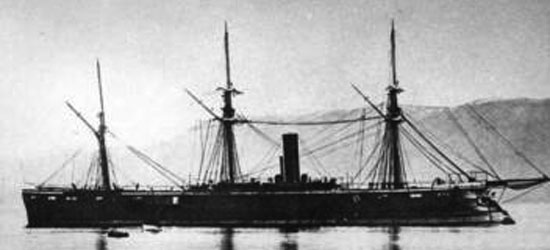
Here as an ironclad, 1870s
Basilissa Olga was one of the two masted ironclads of the Greek Navy in 1870, with Basileos Giorgios. She was built in Stabilimento Tecnico Triestino in Autria (1869, launched 16-1-1870, completed 21-11-1871), armed originally with two 9-in (230 mm) RMLs and ten to twelve 70 pdr guns (206 mm) on the broadside. Armour comprised a belt 6-in thick an 4ft thick battery walls. Quickspecs: 76 x 11.9 x 5.8 m for 2030 tons, VC engines, 1950 ihp, 10 kts, 240 tons coal, 4800 nm /10kts. Crew 258.
In 1894 she was converted in schoolship, rearmed with four 6.7 in/25 and two 6.7 in/20 and four 1-pdr. In 1913 she became an hospital ship, still enlisted in the Hellenic Navy as such during WW1, before being sold for BU in 1925.

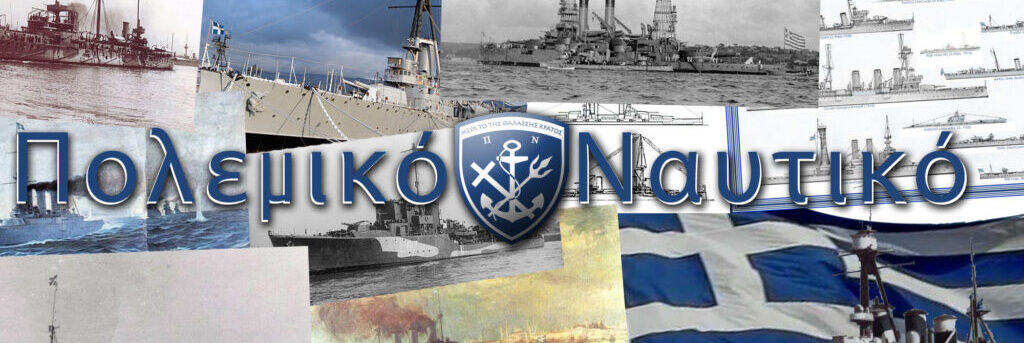
 Latest Facebook Entry -
Latest Facebook Entry -  X(Tweeter) Naval Encyclopedia's deck archive
X(Tweeter) Naval Encyclopedia's deck archive Instagram (@navalencyc)
Instagram (@navalencyc)





 French Navy
French Navy Royal Navy
Royal Navy Russian Navy
Russian Navy Armada Espanola
Armada Espanola Austrian Navy
Austrian Navy K.u.K. Kriegsmarine
K.u.K. Kriegsmarine Dansk Marine
Dansk Marine Nautiko Hellenon
Nautiko Hellenon Koninklije Marine 1870
Koninklije Marine 1870 Marinha do Brasil
Marinha do Brasil Osmanlı Donanması
Osmanlı Donanması Marina Do Peru
Marina Do Peru Marinha do Portugal
Marinha do Portugal Regia Marina 1870
Regia Marina 1870 Nihhon Kaigun 1870
Nihhon Kaigun 1870 Preußische Marine 1870
Preußische Marine 1870 Russkiy Flot 1870
Russkiy Flot 1870 Svenska marinen
Svenska marinen Søværnet
Søværnet Union Navy
Union Navy Confederate Navy
Confederate Navy Armada de Argentina
Armada de Argentina Imperial Chinese Navy
Imperial Chinese Navy Marinha do Portugal
Marinha do Portugal Mexico
Mexico Kaiserliche Marine
Kaiserliche Marine 1898 US Navy
1898 US Navy Sovietskiy Flot
Sovietskiy Flot Royal Canadian Navy
Royal Canadian Navy Royal Australian Navy
Royal Australian Navy RNZN Fleet
RNZN Fleet Chinese Navy 1937
Chinese Navy 1937 Kriegsmarine
Kriegsmarine Chilean Navy
Chilean Navy Danish Navy
Danish Navy Finnish Navy
Finnish Navy Hellenic Navy
Hellenic Navy Polish Navy
Polish Navy Romanian Navy
Romanian Navy Turkish Navy
Turkish Navy Royal Yugoslav Navy
Royal Yugoslav Navy Royal Thai Navy
Royal Thai Navy Minor Navies
Minor Navies Albania
Albania Austria
Austria Belgium
Belgium Columbia
Columbia Costa Rica
Costa Rica Cuba
Cuba Czechoslovakia
Czechoslovakia Dominican Republic
Dominican Republic Haiti
Haiti Hungary
Hungary Honduras
Honduras Estonia
Estonia Iceland
Iceland Eire
Eire Equador
Equador Iran
Iran Iraq
Iraq Latvia
Latvia Liberia
Liberia Lithuania
Lithuania Mandchukuo
Mandchukuo Morocco
Morocco Nicaragua
Nicaragua Persia
Persia San Salvador
San Salvador Sarawak
Sarawak Uruguay
Uruguay Venezuela
Venezuela Zanzibar
Zanzibar Warsaw Pact Navies
Warsaw Pact Navies Bulgaria
Bulgaria Hungary
Hungary

 Bundesmarine
Bundesmarine Dutch Navy
Dutch Navy Hellenic Navy
Hellenic Navy Marina Militare
Marina Militare Yugoslav Navy
Yugoslav Navy Chinese Navy
Chinese Navy Indian Navy
Indian Navy Indonesian Navy
Indonesian Navy JMSDF
JMSDF North Korean Navy
North Korean Navy Pakistani Navy
Pakistani Navy Philippines Navy
Philippines Navy ROKN
ROKN Rep. of Singapore Navy
Rep. of Singapore Navy Taiwanese Navy
Taiwanese Navy IDF Navy
IDF Navy Saudi Navy
Saudi Navy Royal New Zealand Navy
Royal New Zealand Navy Egyptian Navy
Egyptian Navy South African Navy
South African Navy






























 Ukrainian Navy
Ukrainian Navy dbodesign
dbodesign